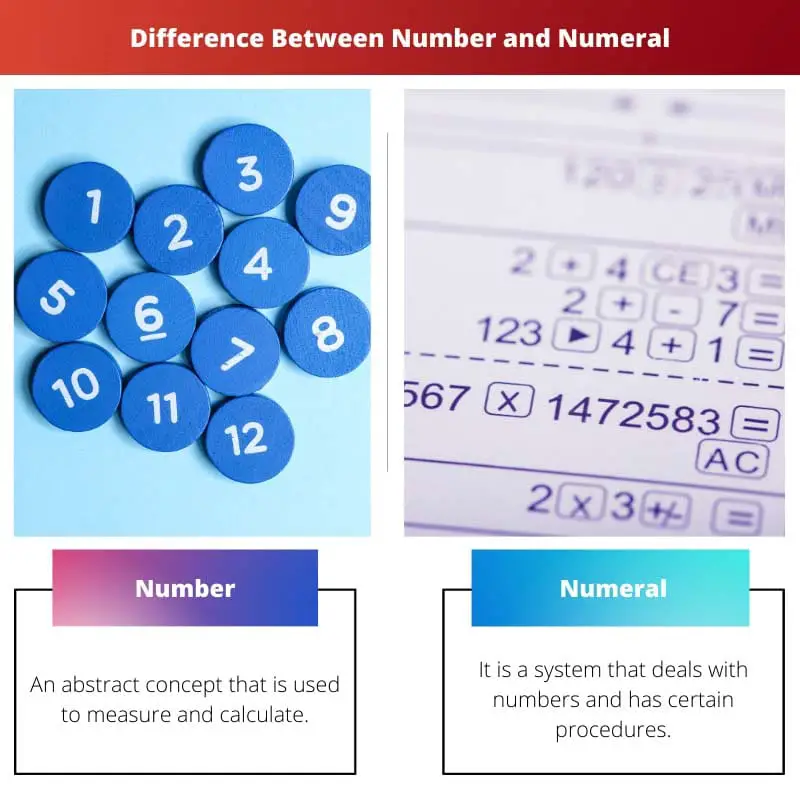Mathematics is a subject that actually cannot be defined. It is a study of a lot of concepts like geometry, algebra, quantity, analysis etc. In mathematics, we solve equations to prove their falsity or truth by giving mathematical proof.
There are many theorems, hypothetical numbers, and algebraic values that are put up in the equation to find solutions. Calculation, measurement and counting are integral to mathematics. Number and numerals are important as it is used to define any value or equation everywhere.
Key Takeaways
- A number represents a mathematical quantity or value, while a numeral is a symbol or group of symbols used to express that number.
- Numbers are abstract concepts, while numerals are concrete representations in various number systems, like Arabic or Roman numerals.
- Different numeral systems can represent the same number differently, such as “4” in Arabic numerals and “IV” in Roman numerals.
Number vs Numeral
A number is an abstract concept that represents a quantity or a count. It is a mathematical concept that can be used to express values, measurements, and other quantitative data. A numeral is a symbol or a group of symbols that represents a number. Numerals can be written in different systems, such as the Arabic, Roman, or Chinese numeral systems.

The number is very common in our life. We use numbers almost everywhere to calculate, count or measure etc. They are represented by digits. Numbers are different from the numeral system. The most common example of numbers is natural numbers which start with 1,2,3,4, and so on.
There are various types of numbers, such as rational numbers, negative numbers, real numbers, π, square root, complex numbers etc. they are used for multiplication, subtraction, addition, exponentiation, and division. This is called arithmetic calculations or number theory.
Numerals are a type of writing system which is also called Numeration. It is also a number system that consists of symbols, alphabets, and digits in a given set sequentially. When a numeral represents any number in its system, then it is called its value.
Numeral systems should represent unique numbers, have a use and value and should reflect arithmetic and algebraic structure. The most common numeral system is the Hindu-Arabic numeral system which is represented by a decimal.
Comparison Table
| Parameters of Comparison | Number | Numeral |
|---|---|---|
| Definition | An abstract concept that is used to measure and calculate. | It is a system that deals with numbers and has certain procedures. |
| Expression | Can be expressed in many ways. | Always represents the same number in a specific system. |
| Types | Negative numbers, Rational numbers, Irrational numbers, Transcendental numbers, Complex numbers, Prime numbers, etc. | Roman, Hindu-Arabic, Egyptian, Binary, unary, etc. |
| Consist of | Digits | Symbols, alphabets, digits, etc. |
| Uniqueness | It is unique. | Not unique |
| Example | 1,5,7,8 ,π, 0 etc | 1×21 + 0×20 + 1×2−1 + 1×2−2 etc. |
What is Number?
The origin of the number can be dated back to prehistoric times when artefacts and bones were identified consisting of tally marks. These marks are believed to be the first form of numbers that were used by early men to count several days, record lunar quantity or keep a record of several animals.
The concept of zero is believed to be first founded by Brahma Gupta in the 7th century in his book Brāhmasphuṭasiddhānta. The first and original examples of numbers that are so commonly used are natural numbers.
Numbers are very important for human civilizations. Besides being an abstract concept and mathematical tool, it also has a cultural significance. For instance, the number 13 is considered a very unlucky number.
Numerology is a mystical belief in numbers that has been common since ancient times. The number is also used for labels such as in telephone, mobile numbers, codes, serial numbers etc. It is very unique. It can be represented in words.
Numbers are very ambiguous. Arithmetic operations like subtraction, multiplication, division etc., are used for calculating numbers. The study of numbers and properties they show is called number theory.
Since the 19th century, numbers have been developed into more and more complex forms and are known as hypercomplex numbers. There are various types of numbers like even, prime, odd, rational, irrational, computable, p-adic, nonstandard, transfinite numbers etc.

What is Numeral?
Hindu-Arabic numeral system is used very often, and Indian mathematicians are given credit for developing integers and decimals, without which calculations would have become very difficult. Aryabhata for developing place value and Brahma Gupta for giving zero to mathematics is very useful.
These numeral systems then spread to different regions of the world, and the concept of digits in Europe was given by Arabs, so it was referred to as Hindu-Arabic System.
The unary numeral system is considered one of the simplest numerals because it is represented in symbols, i.e., tally marks. It has been used since ancient times. It is only used to denote natural numbers. Tally marks are used to represent small numbers, as large numbers are difficult to use.
But it plays an important role in theoretical computer science. Egyptian numeral system existed in 3000 BCE, where numbers have multiples of 10, and higher powers were rounded off. There was no concept of place value in the Egyptian numeral system.
Roman numerals have been used since ancient Roman times. Even after the decline of the Roman empire, it was used. Roman numerals use combinations of letters to represent numbers such as X, I, L, V, D, M etc.
Numerals can be systems of any number, such as a system of real numbers, a system of natural numbers, a system of prime numbers, a system of complex numbers, a system of p-adic numbers etc.
Greeks, Arabians, Romans, everybody has used numerals. Numerals are not unique, as the same number can be represented in many specific ways in the different numeral systems.

Main Differences Between Number and Numeral
- The number is an abstract concept that is used to measure and calculate. The numeral is a system that deals with numbers and has certain procedures.
- The number can be expressed in many ways. Numerals are always represented as the same number in a specific system.
- The number has various types like Negative numbers, Rational numbers, Irrational numbers, Transcendental numbers, Complex numbers, Prime numbers etc. Numerals have various systems like Roman, Hindu-Arabic, Egyptian, Binary, unary etc.
- The number consists of only digits. Numeral consists of symbols, alphabets, digits etc.
- The number is unique. The numeral is not unique.
- Examples of numbers are 1,5,7,8,π, 0 etc. Example of the numeral is 1×21 + 0×20 + 1×2−1 + 1×2−2 etc.




